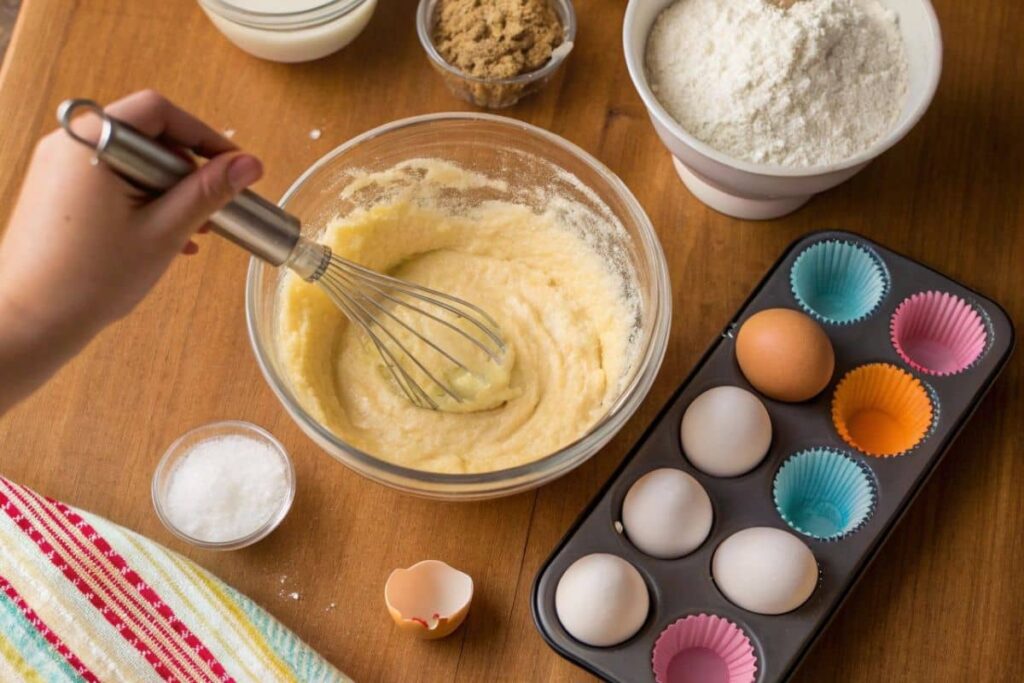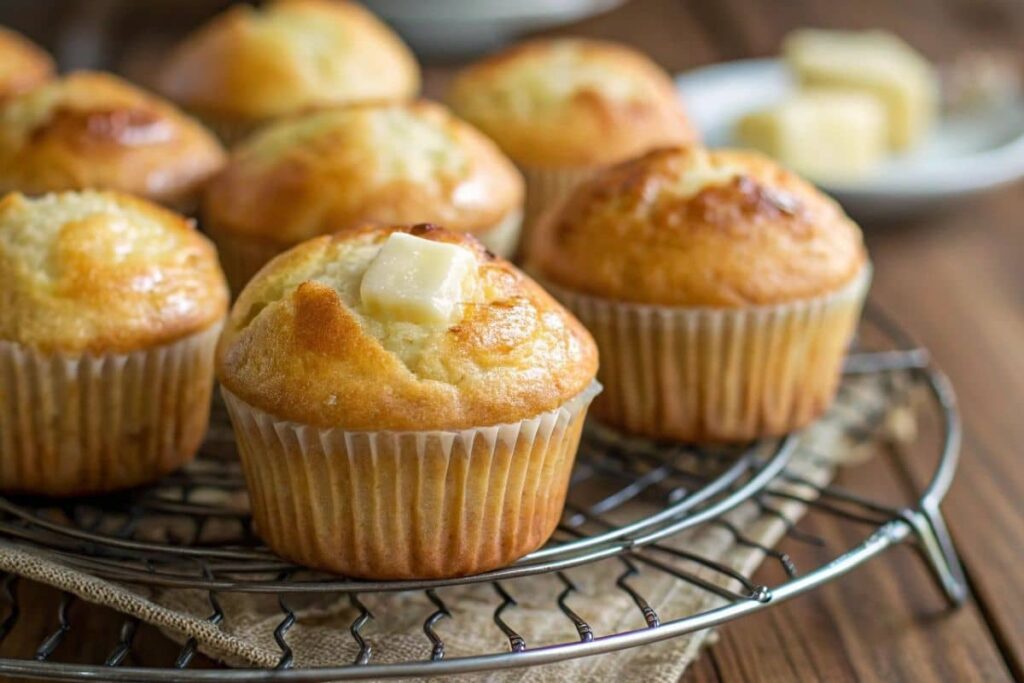The disappointment of flat, dense muffins when you’re craving those impressive, domed treats can be frustrating. If your muffins consistently refuse to reach their full height potential, take heart—you’re facing a common baking challenge with straightforward solutions.
Creating beautifully risen muffins isn’t mysterious or complicated—it’s simply about understanding the science behind the rise. The perfect muffin dome results from a careful balance of ingredients, mixing methods, and baking techniques that work together to create that coveted lift. This guide cuts through the confusion to deliver practical, proven strategies that transform lackluster muffins into impressive, bakery-worthy creations. Ready to elevate your muffin game?
Table of Contents

Understanding What Makes Muffins Rise
Before we explore solutions, let’s take a quick look at the science behind muffin rising. Several factors affect how much lift you get in your muffins, including:
- Leavening agents – Baking powder and baking soda create gas bubbles that help muffins rise.
- Oven temperature – The right heat helps muffins expand properly.
- Mixing method – Overmixing or undermixing the batter can ruin your muffins rise.
- Ingredient ratios – The balance of flour, eggs, and liquid plays a crucial role.
The Role of Leavening Agents in Muffins Rise
Baking powder and baking soda are the two main leavening agents used in muffins. But do you know how they actually work?
Baking Powder vs. Baking Soda: Which One Should You Use?
Baking soda is a base that needs an acid (like lemon juice or buttermilk) to create a chemical reaction that produces carbon dioxide bubbles. Without acid, it won’t do much.
Baking powder, on the other hand, contains both an acid and a base, meaning it starts working as soon as you mix it with liquid and heat it in the oven.
Tip: If your muffins aren’t rising, check if your leavening agents are fresh. To test baking powder, mix a teaspoon with hot water—if it fizzes, it’s still good!
How the Right Oven Temperature Affects Muffins Rise
Did you know that the first 5–10 minutes of baking are crucial for muffins rise? When the batter hits a hot oven, the steam and air bubbles trapped inside expand quickly, causing the muffins to puff up.
Preheating Is Key
Always preheat your oven to the correct temperature before putting your muffins in. A hot oven (around 375–400°F (190–200°C)) creates a rapid rise.
Tip: If your muffins are coming out flat, try starting at a slightly higher temperature (425°F/218°C) for the first 5 minutes, then lowering it for the rest of the baking time.
Mixing Techniques That Help Muffins Rise
Mixing might seem like a small step, but it makes a big difference in muffin texture.
Don’t Overmix the Batter
Overmixing develops too much gluten, leading to tough, dense muffins. Stir just until the dry ingredients are combined with the wet ingredients—lumps are okay!
Use the Muffin Method
The best way to mix muffin batter is to whisk the dry and wet ingredients separately, then gently fold them together. This method keeps the batter light and airy.
Using the Right Ingredients for Maximum Rise

Every ingredient plays a role in how well your muffins rise. Here’s what you should focus on:
- Flour: Stick with all-purpose or a mix of all-purpose and cake flour for the best texture.
- Eggs: Eggs provide structure and help trap air, aiding in rise.
- Milk or Buttermilk: Buttermilk reacts well with baking soda for extra lift.
- Butter vs. Oil: Oil makes muffins moist, but butter adds flavor. A mix of both can be the best of both worlds.
How to Fill Muffin Cups for the Best Rise
How you fill the muffin liners also affects how high they rise.
Tip: For tall muffins, fill the liners almost to the top—about 3/4 full. If you fill them too low, they won’t have enough batter to puff up properly.
Letting the Batter Rest Before Baking
Letting your muffin batter sit for about 15–30 minutes before baking can help develop structure and improve rise. This trick works especially well for recipes with baking powder.
Common Muffin-Rising Problems and How to Fix Them
Still having trouble? Let’s troubleshoot!
Problem: Muffins Didn’t Rise at All
Possible Causes:
- Expired baking powder or baking soda
- Oven temperature too low
- Batter was overmixed
Solution: Use fresh leavening agents, preheat the oven properly, and mix the batter gently.
Problem: Muffins Rose, Then Collapsed
Possible Causes:
- Oven temperature too high, causing muffins to rise too quickly
- Too much leavening agent
Solution: Lower the oven temperature slightly and measure ingredients carefully.
Problem: Muffins Are Dense and Heavy
Possible Causes:
- Batter was overmixed
- Too much flour
- Not enough leavening agent
Solution: Use the muffin mixing method, measure flour correctly, and check your baking powder.
The Ultimate Muffin Recipe for Perfect Rise
Now that you know all the tricks to getting your muffins to rise properly, let’s put that knowledge to the test with this foolproof recipe. This muffin recipe is designed to produce light, fluffy, and well-risen muffins every single time.

The Ultimate Fluffy Muffin Recipe
Ingredients
- 2 ½ cups all-purpose flour
- 1 tablespoon baking powder
- ½ teaspoon baking soda
- ½ teaspoon salt
- ¾ cup sugar
- 2 large eggs
- 1 cup milk or buttermilk
- ½ cup melted butter or vegetable oil
- 1 tablespoon vanilla extract
- 1 cup mix-ins of choice chocolate chips, blueberries, nuts, etc.
Instructions
- Preheat the oven to 375°F (190°C). Line a muffin tin with paper liners or lightly grease it.
- Mix the dry ingredients – In a large bowl, whisk together the flour, baking powder, baking soda, salt, and sugar.
- Prepare the wet ingredients – In another bowl, whisk the eggs, milk (or buttermilk), melted butter (or oil), and vanilla extract until combined.
- Combine wet and dry ingredients – Slowly pour the wet mixture into the dry ingredients, stirring gently with a spatula. Be careful not to overmix; a few lumps are okay!
- Fold in your mix-ins – Gently stir in your chosen mix-ins like chocolate chips, berries, or nuts.
- Fill the muffin cups – Divide the batter evenly among the muffin cups, filling each about ¾ full.
- Bake for 18-22 minutes or until a toothpick inserted into the center comes out clean.
- Cool and enjoy – Let the muffins cool in the pan for 5 minutes, then transfer them to a wire rack. Enjoy warm or store for later!
Notes
- For extra fluffy muffins, use buttermilk instead of regular milk.
- Don’t overmix the batter, or the muffins will be dense.
- If using frozen berries, toss them in a little flour before adding them to the batter to prevent sinking.
- Store muffins in an airtight container at room temperature for up to 3 days or freeze for up to 3 months.

Frequently Asked Questions
1. Why are my muffins flat instead of rising properly?
Flat muffins are often caused by expired leavening agents (baking powder or baking soda), incorrect oven temperature, or overmixing the batter. Make sure your baking powder or soda is fresh, preheat your oven properly, and mix the batter just until combined.
2. How do I get my muffins to rise higher?
To achieve a taller rise, try filling your muffin cups almost to the top, baking at a higher initial temperature (425°F for the first 5 minutes), and ensuring you’re using the correct amount of leavening agent.
3. Should I use baking soda or baking powder for muffins?
It depends on the recipe. Baking powder is generally used for recipes that don’t contain acidic ingredients, while baking soda is best when combined with acidic ingredients like buttermilk, yogurt, or lemon juice. Some recipes use both for the best lift.
4. How does overmixing affect muffin rise?
Overmixing develops too much gluten, making muffins dense and preventing them from rising properly. Always mix just until the dry ingredients are incorporated. Lumps in the batter are completely normal!
5. Can I use self-rising flour to help muffins rise better?
Yes! Self-rising flour already contains baking powder and salt, which can help muffins rise consistently. If substituting for all-purpose flour, adjust the amount of baking powder and salt in the recipe accordingly.
6. Why do my muffins rise unevenly?
Uneven rising can be caused by inconsistent oven temperatures, overfilled muffin liners, or unevenly distributed baking powder. Make sure to rotate your muffin tin halfway through baking for even heat distribution.
7. What happens if I use too much baking powder?
Using too much baking powder can cause muffins to rise too quickly and then collapse, leading to dense or sunken muffins. Stick to the recommended amount—usually about 1 teaspoon per cup of flour.
8. How does oven temperature affect muffin rise?
Starting with a high oven temperature (425°F for the first 5 minutes) helps create a rapid rise by activating the leavening agents quickly. After that, lowering the temperature to 350°F ensures the muffins bake evenly without burning.
9. Can I make muffins rise better without eggs?
Yes! If you’re avoiding eggs, try using substitutes like mashed bananas, unsweetened applesauce, or yogurt. Make sure to use enough leavening to compensate for the lack of egg structure.
10. Do gluten-free muffins rise the same way as regular muffins?
Not always. Gluten-free batters often require extra binding agents like xanthan gum or more eggs to provide structure. If you’re struggling, check out Why Won’t My Gluten-Free Muffins Rise? for expert tips.
11. Why do my muffins shrink after baking?
Muffins shrink when they cool too quickly, especially if taken out of the pan too soon. Let them cool in the pan for 5-10 minutes before transferring to a wire rack.
12. Can I make muffins rise better by resting the batter?
Yes! Letting the batter rest for about 30 minutes before baking can help hydrate the flour and create a better structure, leading to higher, fluffier muffins.
13. Should I use milk or water for better muffin rise?
Milk is usually the better choice because it adds fat and protein, which help improve texture and support better rise. Water can work, but it may result in drier muffins.
14. Can I add extra eggs to make muffins rise more?
Adding too many eggs can make muffins dense rather than fluffy. Stick to the recommended amount, but if your recipe is egg-heavy, try separating the eggs and whipping the egg whites before folding them in to add extra lift.
15. What’s the best way to store muffins so they stay fluffy?
Store muffins in an airtight container at room temperature for up to 3 days. If they start to dry out, warm them slightly in the microwave or oven. For longer storage, freeze them and reheat when needed.
Final Thoughts: Mastering Muffin Rise
Making muffins that rise beautifully is all about using the right techniques. By carefully measuring your ingredients, preheating the oven properly, and allowing the batter to rest, you’ll achieve bakery-style muffins with a perfect dome every time.
After mastering the art of fluffy muffins, why not explore more baking secrets? If you’re wondering What is the secret to moist muffins?, we’ve got the ultimate guide to achieving perfect texture every time. Struggling with gluten-free baking? Find out Why won’t my gluten-free muffins rise? and learn how to fix common issues. For more inspiration, try these delicious recipes: Gluten-Free Pumpkin Muffins for a seasonal treat, 4-Ingredient Banana Bread for a quick and easy bake, or indulge in a sweet, crunchy Cookie Crumble topping for your desserts! Happy baking!
